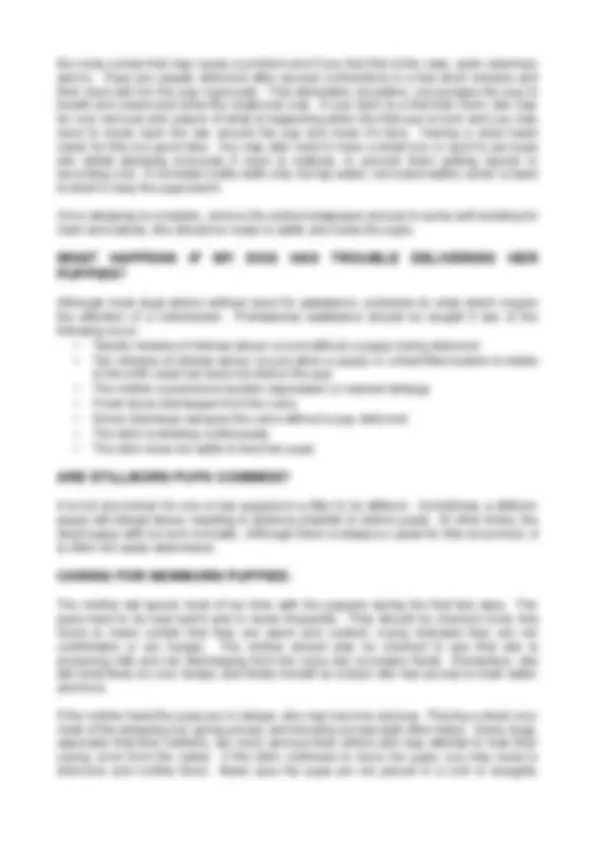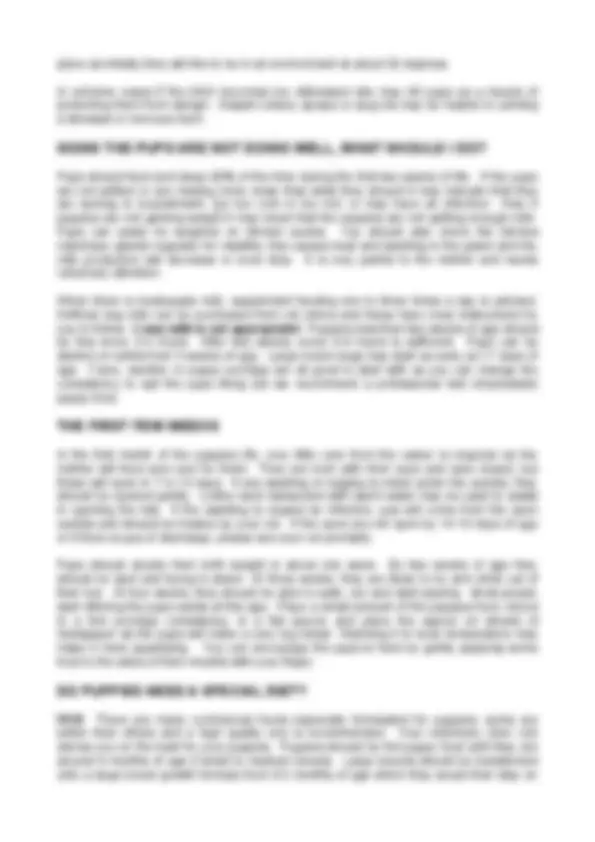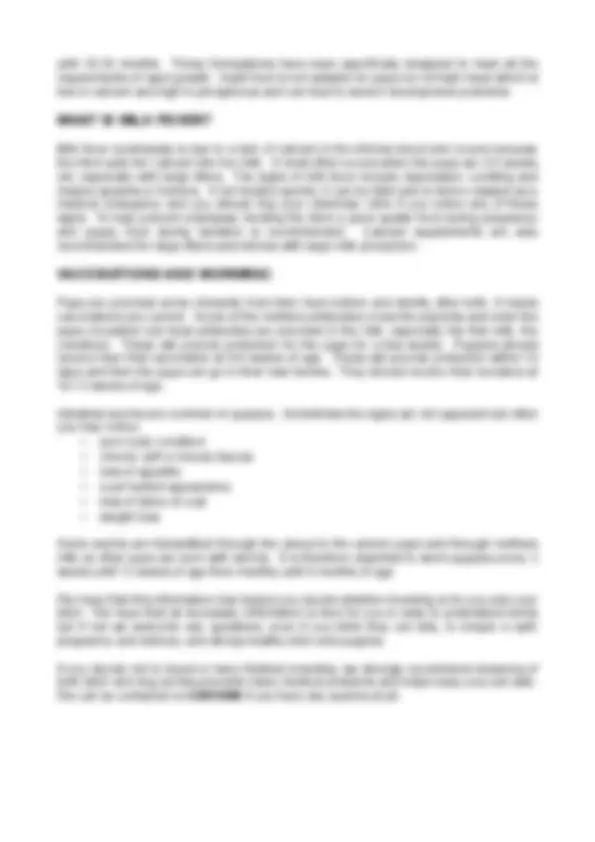





Study with the several resources on Docsity

Earn points by helping other students or get them with a premium plan


Prepare for your exams
Study with the several resources on Docsity

Earn points to download
Earn points by helping other students or get them with a premium plan
Community
Ask the community for help and clear up your study doubts
Discover the best universities in your country according to Docsity users
Free resources
Download our free guides on studying techniques, anxiety management strategies, and thesis advice from Docsity tutors
Comprehensive information on raising a litter of puppies, from the breeding cycle and pregnancy to preparing for whelping and caring for newborns. It covers topics such as the bitch's heat cycle, signs of labor, and caring for the pups during their first few weeks of life. Additionally, it discusses common issues that may arise and how to address them.
What you will learn
Typology: Lecture notes
1 / 5

This page cannot be seen from the preview
Don't miss anything!




Breeding from your bitch and raising her puppies can be an extremely rewarding experience or it may produce frustration and failure. Pet bitches are often torn between their instinctive desire to be with their young and the routines they have acquired with their owners. This can lead to problems and should be considered before breeding is contemplated. Raising a litter of puppies is an extremely time consuming exercise, expensive and one which should not be embarked upon without due consideration. You also need to ask yourself “Why do I want to breed from my bitch? Am I going to be able to find suitable homes for the pups?” Also taking into consideration if the bitch has problems during pregnancy and birth can you afford to have a vet look at her and treat as necessary? After considering all of these things extremely carefully, getting advice from your vet, you still want to breed, then there are a few things you need to know.
A bitch comes into heat every six months on average, although very large breeds of dogs may cycle anything up to once in 15 months. Normally most dogs are on heat for about 3 weeks but this can vary from 4 to 43 days. The breeding cycle consists of two parts, the first part is when you may notice significant vulval swelling and bleeding, the second part (often of equal time) is when the bitch will be receptive of a male and the bleeding should be replaced with a straw coloured discharge. Generally, a bitch will want to mate with a dog between 10 and 14 days after her heat cycle begins. However, the male will want to mate all through this period, and since the bitch will not be interested in the first part of her cycle, this can lead to some fighting so keep a close eye on them if they are together.
There are some tests which can help to determine the best time for mating. Ask your vet for more details of these as the bitches reproductive cycle is very complicated.
Pregnancy (gestation period) normally ranges from 60-67 days with the average being 63 days. Remember to mark on the calendar when the bitch was mated and when to get ready for puppies. Pregnancy blood tests can be performed from 4 weeks after mating and ultrasounds can detect puppies by four weeks into the pregnancy but sometimes earlier than this. Counting pups however can only be done by x-ray when at least 8 weeks into the pregnancy.
It is extremely important that the bitch is in good condition before she is mated, neither too fat or too thin. During the first six weeks of pregnancy she should receive a good quality complete adult diet. During the next three weeks the food intake should gradually increase by about 50% and meals should be split over the day as the growing puppies will take up a lot of stomach room. At the height of lactation, her food requirements may be as much as four times normal especially if she has a large litter. We recommend feeding good quality
puppy food to the bitch during lactation as this provides high energy balanced nutrition, vitamins and minerals, especially calcium, and is easily digested. With large litters we also recommend calcium supplements. Worm your bitch about 6 weeks into pregnancy and just after whelping.
During the last week or so of pregnancy, the bitch will often start looking for a secure place for delivery. Pet bitches can become confused, wanting to be with their owners and at the same time wanting to prepare for the big event. It is recommended that you get the bitch used to the area where you want her to whelp at an early stage, however, some will still want to be near you. If this happens it is best to let her have her way and after the pups are born shift them then, with as little trauma as possible. If preparing a whelping box, it should be large enough for the dog to move around freely, low enough that she can see out and come and go easily, but high enough that the pups can't fall out. Line the box with thick layers of newspaper. These are disposable, absorbent bedding which the bitch can tear up and reorganise as she desires. The paper will absorb the fluids which are always more copious than you would ever expect at the time of whelping and is easily disposed of. You can carefully remove some layers during the birth if necessary, without disturbing mum. The majority of deliveries are without complication; however, owners should attend first time mothers until at least one of two puppies are born. But remember do not interfere unless necessary and only if you know what to do. If you are unsure it is good to have your vets phone number in an obvious place so you can ring them with any questions (which we strongly encourage even in the middle of the night which is when most pups are born).
Signs of impending whelping include nervousness, panting and the bitch will often stop eating during the last 24 hours before labour beings. If you can take your dogs temperature, this will usually drop 24-48 hours before delivery also. Labour can be divided into three stages, the first stage is when the bitch starts looking for a place to deliver, she may seem quite uncomfortable, agitated and restless. This is called nesting and the bitch will be having some contractions by the end of this stage. The second stage is when the bitch will actually start to push and the pups will be delivered. Stage three is the delivery of the placenta (afterbirth) which the bitch will often eat. The placentas usually follow each pup. Delivery of the first pup may take up to one hour. After the first pup, the bitch, especially a first time mum, may rest for up to two hours. Small dogs may deliver an entire litter within a few hours whereas a large dog may take many hours. If the bitch is straining and nothing seems to be happening, please seek advice. After the pups are born, the bitch will have a dark green discharge for up to a week. If you notice blood or smelly discharge please contact your vet.
Puppies are normally born head first with front legs next to their noses but tail first (posterior presentation) is also common. If the back legs are coming first, delivery is usually not a problem, however breech presentation where the legs are folded forward and
place as initially they will like to be in an environment at about 30 degrees. In extreme cases if the bitch becomes too distressed she may kill pups as a means of protecting them from danger. Adaptil collars, sprays or plug ins may be helpful in calming a stressed or nervous mum.
Pups should feed and sleep 90% of the time during the first two weeks of life. If the pups are not settled or are making more noise than what they should it may indicate that they are lacking in nourishment, are too cold or too hot, or may have an infection. Also if puppies are not gaining weight it may mean that the puppies are not getting enough milk. Pups can easily be weighed on kitchen scales. You should also check the bitches mammary glands regularly for mastitis, this causes heat and swelling in the gland and the milk production will decrease or even stop. It is very painful to the mother and needs veterinary attention. When there is inadequate milk, supplement feeding one to three times a day is advised. Artificial dog milk can be purchased from vet clinics and these have clear instructions for you to follow. Cows milk is not appropriate! Puppies less than two weeks of age should be few every 3-4 hours. After two weeks, every 6-8 hours is sufficient. Pups can be started on solids from 3 weeks of age. Large breed dogs may start as early as 17 days of age. Farex, weetbix or puppy porridge are all good to start with as you can change the consistency to suit the pups liking but we recommend a professional diet rehydratable puppy food.
In the first month of the puppies life, very little care from the owner is required as the mother will feed and care for them. They are born with their eyes and ears closed, but these will open in 7 to 14 days. If any swelling or bulging is noted under the eyelids, they should be opened gently. Cotton wool dampened with warm water may be used to assist in opening the lids. If the swelling is caused by infection, pus will come from the open eyelids and should be treated by your vet. If the eyes are not open by 14-16 days of age or if there is pus of discharge, please see your vet promptly. Pups should double their birth weight in about one week. By two weeks of age they should be alert and trying to stand. At three weeks, they are likely to try and climb out of their box. At four weeks, they should be able to walk, run and start playing. Most people start offering the pups solids at this age. Place a small amount of the puppies food, mixed to a thin porridge consistency, in a flat saucer and place the saucer on sheets of newspaper as the pups will make a very big mess! Warming it to body temperature may make it more appetising. You can encourage the pups to feed by gently applying some food to the sides of their mouths with your finger.
YES! There are many commercial foods especially formulated for puppies, some are better than others and a high quality one is recommended. Your veterinary clinic can advise you on the best for your puppies. Puppies should be fed puppy food until they are around 9 months of age if small to medium breeds. Large breeds should be transitioned onto a large breed growth formula from 4-5 months of age which they would then stay on
until 18-24 months. These formulations have been specifically designed to meet all the requirements of rapid growth. Adult food is not suitable for pups nor is fresh meat which is low in calcium and high in phosphorus and can lead to severe development problems.
Milk fever (eclampsia) is due to a lack of calcium in the bitches blood and occurs because the bitch puts her calcium into her milk. It most often occurs when the pups are 3-5 weeks old, especially with large litters. The signs of milk fever include depression, vomiting and muscle spasms or tremors. If not treated quickly, it can be fatal and is hence classed as a medical emergency and you should ring your veterinary clinic if you notice any of these signs. To help prevent eclampsia, feeding the bitch a good quality food during pregnancy and puppy food during lactation is recommended. Calcium supplements are also recommended for large litters and bitches with large milk production.
Pups are provided some immunity from their mum before and shortly after birth, if mums vaccinations are current. Some of the mothers antibodies cross the placenta and enter the pups circulation but most antibodies are provided in the milk, especially the first milk, the colostrum. These will provide protection for the pups for a few weeks. Puppies should receive their first vaccination at 6-8 weeks of age. These will provide protection within 10 days and then the pups can go to their new homes. They should receive their boosters at 10-12 weeks of age. Intestinal worms are common in puppies. Sometimes the signs are not apparent but often you may notice: